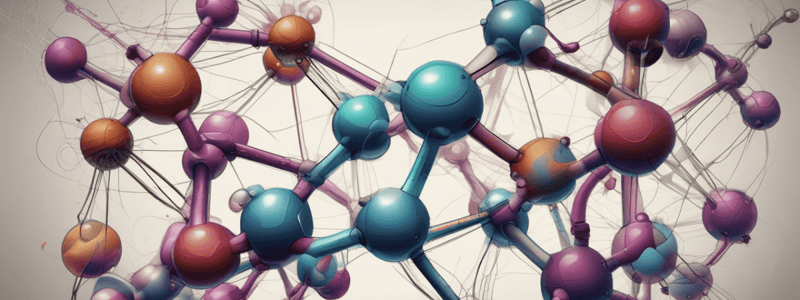Podcast
Questions and Answers
What is the general formula for alkanes?
What is the general formula for alkanes?
- CₙH₂ₙ₊₁
- CₙH₂ₙ
- CₙH₂ₙ₊₂ (correct)
- CₙH₂ₙ₋₂
What is the characteristic of saturated hydrocarbons?
What is the characteristic of saturated hydrocarbons?
- They contain at least one carbon to carbon triple bond
- They have a benzene ring in their structure
- They have only single carbon to carbon covalent bonds (correct)
- They contain at least one carbon to carbon double bond
What is the name of the C₅ alkane?
What is the name of the C₅ alkane?
- Pentane (correct)
- Butane
- Hexane
- Heptane
What is the test to determine unsaturation in hydrocarbons?
What is the test to determine unsaturation in hydrocarbons?
What is the structure and formula of cyclohexane?
What is the structure and formula of cyclohexane?
Which of the following is an aromatic hydrocarbon?
Which of the following is an aromatic hydrocarbon?
What is the formula of 2,2,4-trimethylpentane?
What is the formula of 2,2,4-trimethylpentane?
What is the general formula for alkenes?
What is the general formula for alkenes?
What is the shape of saturated hydrocarbons?
What is the shape of saturated hydrocarbons?
What is the name of the C₃ alkene?
What is the name of the C₃ alkene?
What is the solubility of alkanes?
What is the solubility of alkanes?
What is the characteristic of cyclohexane?
What is the characteristic of cyclohexane?
What is the general formula for alkynes?
What is the general formula for alkynes?
What is the name of the C₂ alkyne?
What is the name of the C₂ alkyne?
Flashcards are hidden until you start studying
Study Notes
Hydrocarbons
- Hydrocarbons are compounds consisting of hydrogen and carbon only, bonded together covalently.
- They are commonly used as fuels.
- Examples include crude oil, methane, alkanes, alkenes, and alkynes.
Classification of Hydrocarbons
- Aliphatic hydrocarbons: consist of chains of carbon or certain rings of carbon.
- Aromatic hydrocarbons: include a benzene ring in their structure.
Cyclohexane
- Cyclohexane is a saturated compound containing only C – C bonds.
- It is an important non-polar solvent.
- Despite having polar C-H bonds, it is non-polar overall due to symmetry.
- Non-polar solutes will dissolve in non-polar solvents.
- Its structural formula is C6H12.
Saturated and Unsaturated Hydrocarbons
- Saturated hydrocarbons: have only single carbon to carbon covalent bonds.
- Unsaturated hydrocarbons: contain at least one carbon to carbon double or triple bond.
- Test for unsaturation: Turn acidified KMnO4 from pink to colorless, or decolourise red/brown bromine water.
Homologous Series
- A homologous series is a family of organic compounds with the same general formula, similar chemical properties, and successive members differing by CH2.
- Examples include alkanes, alkenes, and alkynes.
Alkanes
- General formula: CnH2n+2.
- Bond type: C - C.
- Solubility: Alkanes are non-polar, soluble in cyclohexane, and insoluble in water.
- Examples: C1 → C4 are gases, C5 → C15 are liquids, and ≥ C16 are waxy solids.
- Must know: names and structural formulas up to C8, structural isomers of C4 and C5.
Alkenes
- General formula: CnH2n.
- Bond type: C = C.
- Solubility: Alkenes are non-polar, soluble in cyclohexane, and insoluble in water.
- Examples: C2 → C4 are gases, and ≥ C5 are liquids or solids.
- Must know: names and structural formulas up to C4, structural isomers of C4.
Alkynes
- General formula: CnH2n-2.
- Bond type: C ≡ C.
- Solubility: Alkynes are non-polar, soluble in cyclohexane, and insoluble in water.
- Examples: C2H2 is a gas.
- Must know: names and structural formulas up to C2 alkyne, uses of C2 alkyne.
- Ethyne (C2H2): used in welding, burns in oxygen at approx. 3,000°C, has a sweetish scent, and burns in air with a sooty flame.
Studying That Suits You
Use AI to generate personalized quizzes and flashcards to suit your learning preferences.




